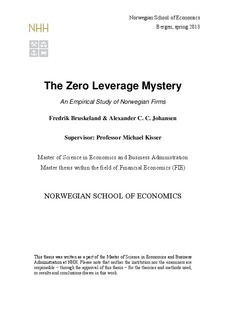| dc.description.abstract | The objective of this thesis is to document the puzzling evidence of Norwegian firms, both public and private, following a zero leverage policy. We have examined accounting data for all Norwegian firms in the period from 1993 to 2010. One of the most interesting findings from our study is that 19.1% of all private firms in the whole period had zero outstanding debt, which is more than twice as high when compared to public companies. Our results show that 29.2% of the private firms also had less than 5% book leverage, which is almost three times the rate for public firms. We found that zero leverage firms are smaller, more profitable, have larger cash balances, pay more dividends, have higher ratings, less tangible assets and they pay more taxes compared to firms with leverage. Firms are most profitable in the year they become zero leveraged, which is also the year they have the largest cash balances (as a ratio of total assets). Further on we find that zero leveraged firms differ quite substantially among themselves, especially when we compare dividend payers versus non-dividend payers. Our results indicate that zero leverage may be a persistent phenomenon, with almost 26% of zero leverage firms refraining from debt for at least 8 consecutive years. | no_NO |
